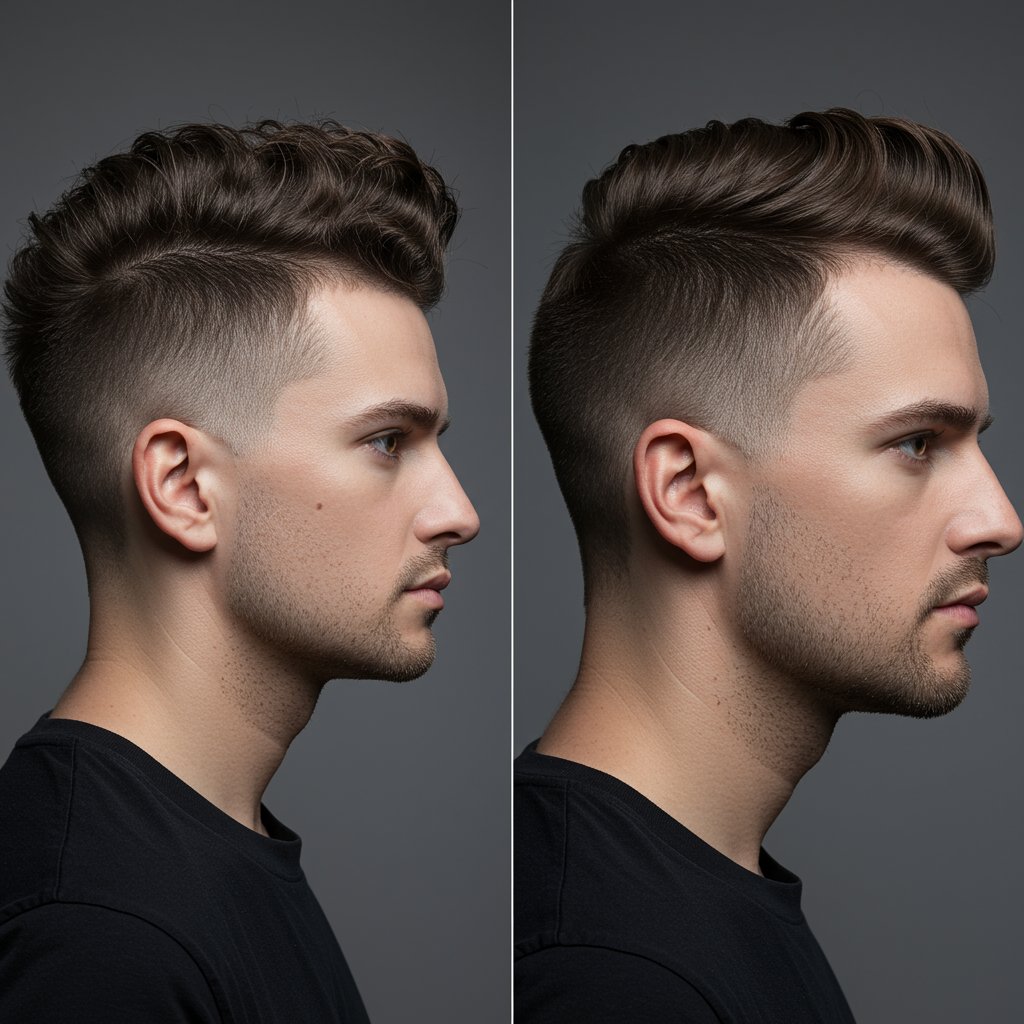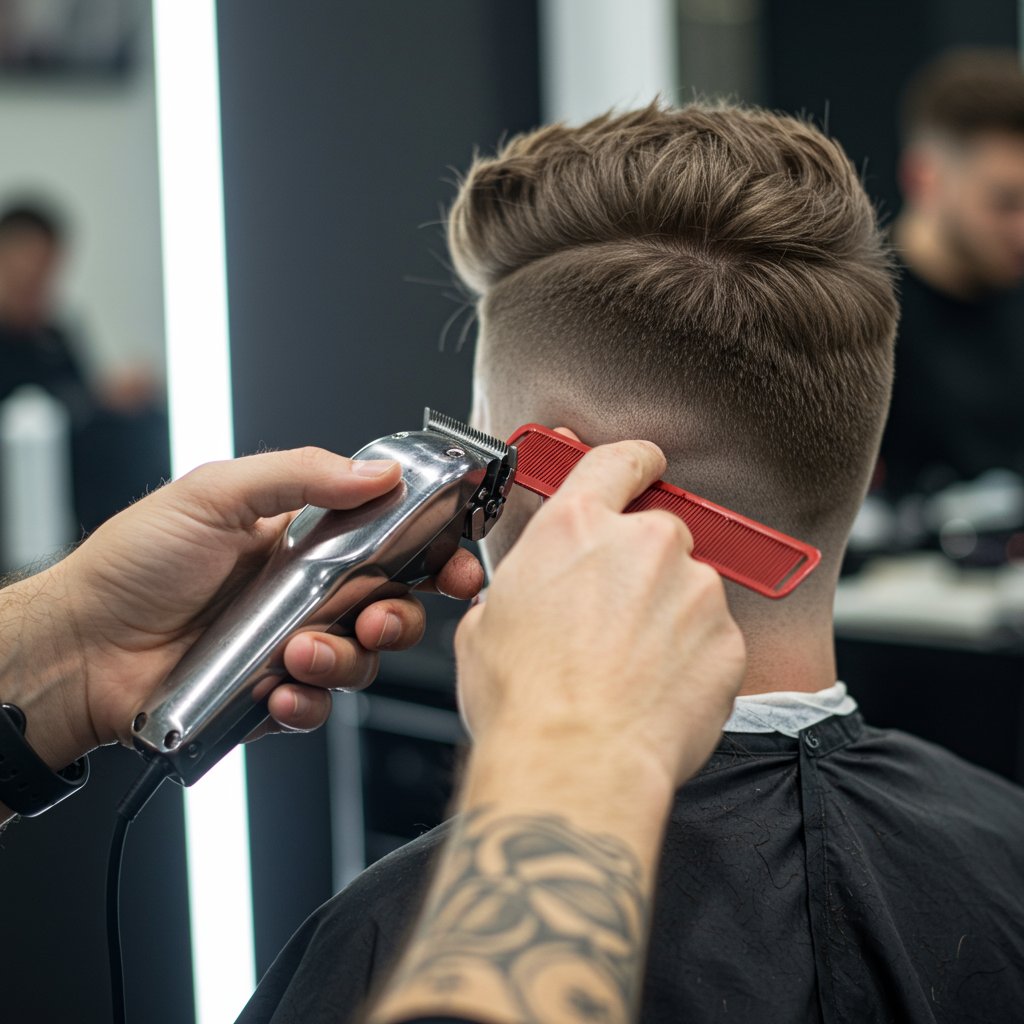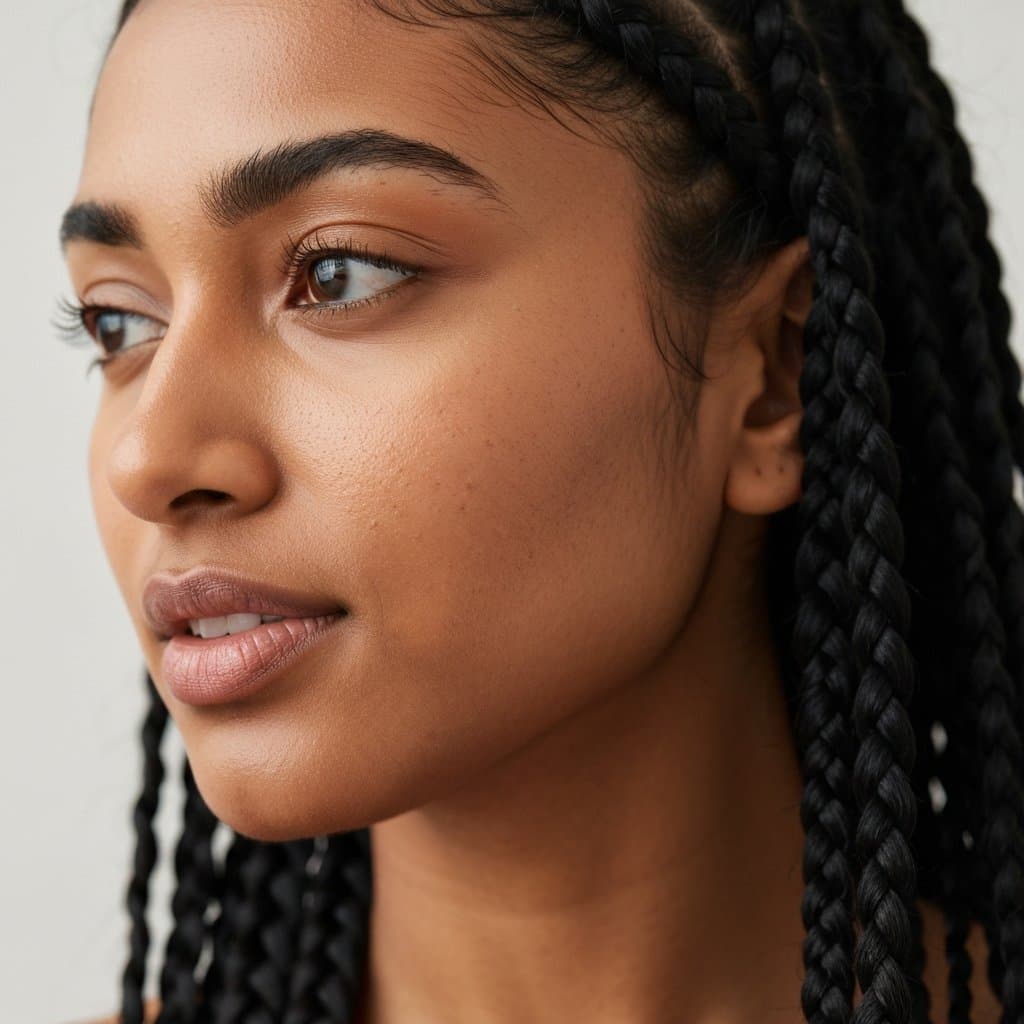Mohawks and Faux Hawks: The Ultimate Guide to Punk-Inspired Hair | Styles, History & Tips
From Rebellion to Runway: An Introduction to Mohawks and Faux Hawks
Few hairstyles carry the same weight of cultural significance and visual impact as the mohawk. A bold declaration of individuality, it has journeyed from ancient warrior traditions to the heart of the punk rock rebellion and onto high-fashion runways. Today, its spirit lives on not only in its classic form but also through its more accessible and versatile cousin, the faux hawk. This guide to mohawks and faux hawks will explore the rich history, diverse variations, and expert techniques behind these iconic punk-inspired hairstyles. Whether you're contemplating the full commitment of shaved sides or seeking a less permanent way to express your edgy side, understanding the nuances of these cuts is the first step toward achieving a look that is both striking and personally authentic.

For decades, these styles have been synonymous with counter-culture, music, and a refusal to conform. But in the modern era, they have evolved. The sharp lines of a classic mohawk and the textured peak of a faux hawk are now seen on everyone from rockstars and artists to entrepreneurs and office workers. They represent a fusion of rebellion and refinement, a testament to the enduring power of a haircut that makes a statement. In this comprehensive overview, we will deconstruct the anatomy of both styles, provide inspiration for your next salon visit, and equip you with the knowledge to style and maintain your new look with confidence. Get ready to explore the world of punk-inspired hair and find the perfect hawk for you.
The Rebel's Roar: A Brief History of the Mohawk
The story of the mohawk is far older and more complex than the 1970s punk scene that made it famous. Its roots trace back to the Indigenous peoples of North America, specifically the Pawnee Nation of modern-day Nebraska and Kansas. The style, characterized by a scalp shaved bare except for a ridge of hair in the middle, was historically worn by Pawnee warriors. It was a symbol of strength and defiance, a formidable sight for their enemies. The name itself, however, was an exonym, mistakenly linked by Hollywood to the Mohawk (Kanien'kehá:ka) people, who traditionally wore a different style—a square of hair at the back of the head, with the rest plucked out. The 1939 film Drums Along the Mohawk cemented this misnomer in the public consciousness, creating an image that would later be co-opted by new generations of rebels.

Fast forward to the 1970s and 1980s, when London and New York were epicenters of a cultural explosion. The punk rock movement adopted the mohawk as its unofficial uniform. It was a visceral, visual rejection of mainstream societal norms, a middle finger to the polished, feathered hairstyles of the era. Bands like The Exploited and The Clash popularized the look, often dyeing the central strip in vibrant, unnatural colors and sculpting it into gravity-defying spikes. This wasn't just a haircut; it was a political statement, a symbol of anti-authoritarianism, and a badge of belonging for a disenfranchised youth culture. It was meant to be shocking, confrontational, and unequivocally different.
From the gritty clubs of the punk scene, the mohawk began its slow march into wider cultural acceptance. It appeared in films, on fashion runways, and was adopted by various subcultures, from goth to cybergoth, each adding its own unique twist. This evolution paved the way for more mainstream interpretations, eventually giving rise to the faux hawk. The core spirit of the mohawk—its boldness, its individuality, and its inherent defiance—remains, proving that a truly powerful hairstyle never really goes out of style; it just finds new ways to make its voice heard.
The Classic Mohawk vs. The Modern Faux Hawk: What's the Difference?
While they share a name and a general silhouette, the classic mohawk and the modern faux hawk are fundamentally different in both structure and commitment. Understanding these distinctions is crucial before you sit down in the stylist's chair. The choice between them hinges on your lifestyle, your willingness to maintain the cut, and the level of intensity you want your look to project. Both are powerful statements, but they speak in different volumes.

The Authentic Mohawk: The Definition of Defiance
The authentic, classic mohawk is defined by its stark contrast. The sides of the head are completely shaved, often down to the skin with a razor or zero-guard clippers, leaving a single, distinct strip of longer hair running from the forehead to the nape of the neck. The width of this strip can vary, from a narrow "fin" to a wider, more substantial band. This cut is a true commitment. There is no hiding it; the shaved sides are a permanent feature until they grow out. It requires frequent touch-ups at a professional salon (every 2-4 weeks) to keep the shaved sections clean and the lines sharp. Styling is often intensive, requiring strong-hold products to sculpt the central strip into the iconic fan or spikes.The Versatile Faux Hawk: The Adaptable Rebel
The faux hawk, or "fohawk," is the mohawk's adaptable and office-friendly sibling. It mimics the silhouette of a mohawk without the commitment of shaved sides. The style is achieved by cutting the sides and back significantly shorter than the hair on top. This can be done with a fade, a taper, or simply a shorter scissor-over-comb cut. The longer hair on top is then styled upwards and towards the center, creating the characteristic peak. The beauty of the faux hawk lies in its versatility. For a professional setting, it can be styled subtly with a light pomade. For a night out, it can be pushed higher and given more texture for a dramatic, edgy look. It grows out more gracefully than a classic mohawk and doesn't require the same rigorous maintenance schedule.Types of Mohawks: From Subtle to Extreme
The traditional mohawk is just the beginning. Over the years, subcultures and creative individuals have spun the classic style into a multitude of fascinating variations. Each one carries a different aesthetic and level of intensity, allowing for a more personalized expression of the punk-inspired look. Exploring these options can help you and your stylist design a mohawk that truly fits your personality.

The Deathhawk
Born from the goth subculture, the Deathhawk is a dramatic and theatrical take on the mohawk. It typically involves a wider strip of hair than the classic version. The key to the Deathhawk is the styling: the hair is heavily teased and backcombed at the roots to create immense volume and a wider, fuller shape. It's then held in place with copious amounts of strong-hold hairspray. Often dyed jet black or dark, moody colors, the Deathhawk is less about sharp spikes and more about a dark, imposing silhouette.The Frohawk
An incredible adaptation for those with curly, coily, or kinky hair textures, the Frohawk celebrates natural volume. Instead of forcing the hair into straight spikes, this style works with the hair's inherent texture. The sides are typically faded or cut very short, allowing the natural curls on top to be shaped upwards and towards the center. The result is a powerful, beautifully textured hawk that showcases the hair's natural pattern. It's a fantastic way to embrace an edgy look while honoring natural hair.The Liberty Spike Hawk
This is perhaps the most quintessential punk rock mohawk. The Liberty Spike Hawk consists of long, perfectly formed, sharp spikes that resemble the crown of the Statue of Liberty. Achieving this look is an art form, requiring patience and industrial-strength products like hair glue or the strongest gels and sprays available. Each spike is carefully separated and sculpted to a fine point. Often dyed in vibrant, neon colors, this style is the ultimate in anti-establishment hair.Exploring the Faux Hawk Family
Just as the mohawk has its variations, the faux hawk boasts a diverse family of styles that cater to different hair types, lengths, and aesthetic preferences. Its inherent flexibility makes it a canvas for creativity, allowing for looks that range from boardroom-appropriate to concert-ready. A skilled stylist can tailor a faux hawk to perfectly suit your face shape and personal style.

The Tapered Faux Hawk
A favorite for its clean and polished appearance, the tapered faux hawk is a masterpiece of barbering. The sides are gradually faded from a longer length near the parietal ridge down to a shorter length, often skin-tight, at the sideburns and neckline. This seamless transition, or taper, creates a sharp, refined foundation for the longer hair on top. The top can then be styled with a medium-hold product for a look that's edgy yet sophisticated, making it one of the most popular and workplace-friendly versions of the style.The Shaggy Faux Hawk
For a more relaxed, undone vibe, the shaggy faux hawk is the perfect choice. Instead of a tight fade, the sides are often left a bit longer and cut with scissors to create texture. The top is also heavily textured with layers, resulting in a messier, more piecey look. This style is less about a perfect peak and more about a general upward, central direction. It's low-maintenance and works well for those with wavy or straight hair who prefer a less structured, more rock-and-roll aesthetic.The Long Hair Faux Hawk
You don't need short hair to rock a hawk. The long hair faux hawk is a temporary styling technique rather than a cut. It's created by pulling the side sections of the hair back tightly against the scalp, securing them with pins, braids, or a sleek gelled finish. This leaves the central section of hair loose, which can then be teased and styled upwards to create the illusion of a mohawk. It's a fantastic, commitment-free option for special events or for anyone wanting to experiment with an edgier look without reaching for the clippers.The Cut: Achieving the Perfect Mohawk or Faux Hawk
Translating your vision for a mohawk or faux hawk into reality requires precision, skill, and a deep understanding of head shape and hair growth patterns. This is not a DIY project for the faint of heart; the sharp lines and balanced proportions are best left to an experienced professional stylist. The process begins long before the first snip of the scissors or buzz of the clippers.

Consultation is Key
The most critical step is a thorough consultation with your stylist. This is where you discuss your lifestyle, maintenance commitment, and desired level of intensity. Bring inspiration photos of the specific styles you like. A great stylist will analyze your face shape, hair texture, and density to advise on the most flattering width for a mohawk strip or the perfect fade height for a faux hawk. They will also discuss the grow-out process and set realistic expectations for upkeep.For the Mohawk: Precision and Boldness
Creating a classic mohawk is a feat of precision. The stylist will first section off the central strip of hair that will remain, ensuring the lines are perfectly symmetrical. The width and placement are customized to your head shape. Then, using clippers, they will remove the hair on the sides. The choice of guard (or no guard for a skin-close finish) will be determined during the consultation. The process often involves using trimmers to create razor-sharp outlines around the strip. Finally, the top section is cut and textured to facilitate the desired styling, whether it's for fanning or spiking.For the Faux Hawk: Blending and Texturizing
Crafting a faux hawk is an exercise in the art of blending. The stylist will typically use a combination of clippers and scissors. The sides are often faded or tapered, requiring a masterful hand to create a smooth, seamless gradation in length. The top section is left significantly longer and is usually point-cut or texturized with shears to remove bulk and encourage the hair to stand up and move towards the middle. This texturizing is what gives the faux hawk its signature piecey, modern look and makes it easier to style at home.Master the Style: Products and Techniques for Gravity-Defying Hair
Getting the perfect cut is only half the battle; daily styling is what truly brings your mohawk or faux hawk to life. The right products and techniques are essential to achieve the height, hold, and texture that define these looks. Your styling arsenal will differ depending on whether you've opted for a full mohawk or a versatile faux hawk.

The Essential Toolkit
For any hawk style, a powerful hairdryer with a concentrator nozzle is your best friend—it helps direct the hair upwards from the root. For a classic mohawk, you'll need industrial-strength products: think hair glues (like Got2b Glued), extreme-hold gels, and freeze-hold hairsprays. A teasing comb is also crucial for building a solid foundation of volume. For a faux hawk, the toolkit is more forgiving. A quality pomade (matte or shine), texturizing wax, or a firm-hold clay will provide the pliability and hold needed to shape the style without making it feel like a helmet.Step-by-Step Mohawk Styling
Achieving a classic spiked or fanned mohawk is a process. Start with clean, completely dry hair. Section by section, apply a strong-hold gel or glue from root to tip. For spikes, separate a small section of hair, twist it at the base, and smooth the product upwards to a point. Use a hairdryer to "freeze" each spike in place before moving to the next. For a fan, use a comb to pull the entire strip of hair straight up, then apply product and use two hairdryers (one on each side) to dry it into a solid, flat wall of hair. Finish the entire style with a generous blast of freeze-spray.Effortless Faux Hawk Styling
Styling a faux hawk is significantly quicker. Start with towel-dried hair. Apply a small amount of your chosen product (pomade, wax, or clay) evenly throughout the longer hair on top. Using your fingers or a comb, push the hair upwards and towards the center. Use a hairdryer and your fingers to direct the hair, creating lift at the roots and texture on the ends. For a messier look, tousle the hair as you dry. For a more defined peak, use your palms to press the sides of the styled section together. The goal is controlled chaos with a clear, hawk-like shape.Tips for Maintaining Your Edgy Look
Maintaining a mohawk or faux hawk requires a dedicated routine to keep it looking sharp and feeling healthy. From scalp care to regular trims, consistent upkeep is the key to ensuring your statement style doesn't lose its impact. Proper maintenance prevents issues like scalp irritation and damaged hair, which can result from intense styling.

Scalp Care for Shaved Heads
For those with a classic mohawk, the exposed, shaved skin on the sides of your head needs special attention. This area is prone to dryness, irritation from clippers, and sunburn. Use a gentle, moisturizing cleanser when you wash your hair, and don't neglect the shaved areas. After showering, apply a lightweight, non-comedogenic moisturizer or a soothing aftershave balm to prevent dryness and razor burn. Most importantly, always apply a broad-spectrum sunscreen with at least SPF 30 to your scalp before going outside. The skin on your head is highly susceptible to sun damage.Keeping the Top Healthy
The long hair in your hawk undergoes a lot of stress from strong-hold products and heat styling. To counteract potential damage, incorporate a deep conditioning treatment or a hair mask into your routine once a week. When washing your hair, use a clarifying shampoo periodically (once every 1-2 weeks) to remove product buildup, which can weigh hair down and dull its appearance. Follow up with a hydrating conditioner to restore moisture. Minimizing heat styling on days you don't need a perfect, sky-high style will also help preserve the health of your hair.Regular Trims are Non-Negotiable
Consistency is key to keeping your hawk looking intentional and sharp. For a classic mohawk, you'll likely need a salon visit every 2 to 4 weeks to re-shave the sides and keep the lines clean. For a faux hawk with a fade, a touch-up every 3 to 5 weeks is ideal to maintain the blend. Letting it go too long can make the style look unkempt and lose its distinctive shape. Pre-booking your next appointment when you leave the salon is a great way to stay on schedule.Frequently Asked Questions About Mohawks and Faux Hawks
Q1: Is a mohawk damaging to my hair?
The cut itself isn't damaging. However, the intensive styling required for classic mohawks—using heavy products, teasing, and heat—can lead to breakage and dryness if not managed properly. Regular deep conditioning and giving your hair occasional breaks from styling can mitigate this damage. The faux hawk is generally much gentler on hair as it requires less intense products and techniques.Q2: How long does my hair need to be for a mohawk or faux hawk?
For a classic mohawk, you'll need at least 2-3 inches to create small, noticeable spikes. For taller, more dramatic styles like Liberty Spikes, you'll need 5 inches or more. For a faux hawk, you can achieve the look with as little as 1.5-2 inches on top, as the style relies more on the contrast with the shorter sides than on extreme length.Q3: Can I get a faux hawk with thin or fine hair?
Absolutely! A faux hawk can actually be a great style for thinner hair. A skilled stylist can use texturizing techniques to create the illusion of more volume and fullness. Using a matte-finish, lightweight product like a texture powder or clay will add grit and lift without weighing the hair down.Q4: How do I wash out extreme-hold styling products like hair glue?
Don't just jump in the shower and hope for the best. The key is to break down the product before you introduce water. Apply a generous amount of conditioner to your dry, styled hair and work it through, massaging it in to dissolve the glue or gel. Let it sit for a few minutes. Then, rinse thoroughly with warm water before proceeding with your normal shampoo and conditioning routine.Q5: Is a mohawk appropriate for a professional workplace?
This depends heavily on your industry and company culture. A classic, brightly colored Liberty Spike mohawk is unlikely to be acceptable in a corporate environment. However, a short, neatly styled mohawk or, more commonly, a well-groomed tapered faux hawk is often perfectly acceptable in many modern, creative, and even corporate workplaces. When in doubt, opt for the subtlety of the faux hawk.Q6: What's the best way to grow out a mohawk?
The grow-out phase can be awkward, but there are strategies. The first step is to stop shaving the sides and let them grow. As the sides start to fill in, you can trim the top strip to lessen the contrast, transitioning into a longer faux hawk or a textured crew cut. Working with a stylist during this phase is highly recommended, as they can help shape the hair at each stage to make the transition as smooth as possible.Conclusion: Embrace Your Edge
From the warrior fields of the Pawnee Nation to the punk clubs of London and the modern-day boardroom, the mohawk and its descendant, the faux hawk, have proven to be more than just haircuts—they are powerful forms of self-expression. They are a declaration of confidence, a nod to a rebellious spirit, and a celebration of individuality. Whether you choose the unyielding commitment of the classic mohawk or the adaptable chic of the faux hawk, you are choosing a style that commands attention and tells a story.
The journey to the perfect punk-inspired haircut is a personal one. It requires an understanding of the history, an appreciation for the different styles, and a partnership with a skilled stylist who can bring your vision to life. Armed with the knowledge from this guide, you can confidently choose the cut, products, and maintenance routine that fit your life and your unique personality. So go ahead, consult a professional, and dare to embrace your edge. The world is your stage, and your hair can be your masterpiece.


